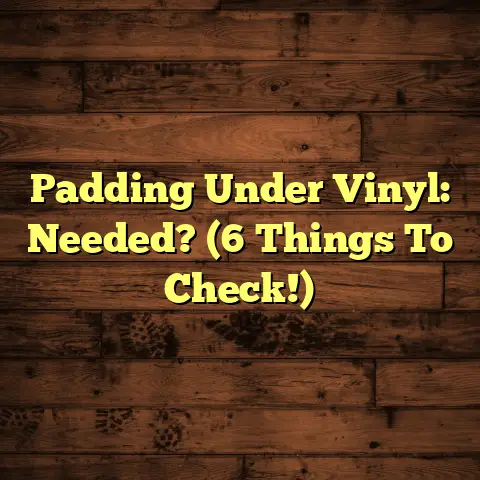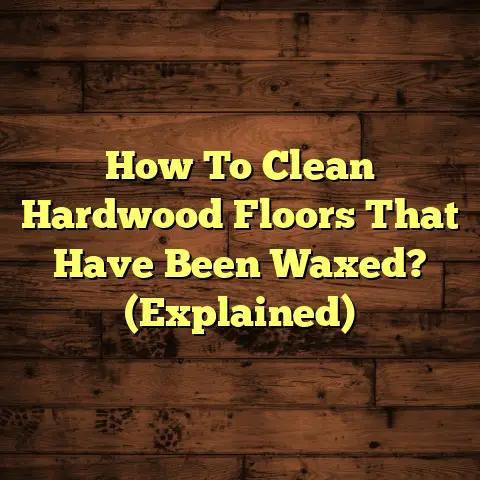Fixing Laminate Floor Water Damage (9 Hour Save!)
She loves hosting family gatherings, where laughter and stories fill the air, and the kitchen becomes the heart of her home. However, last week’s unexpected plumbing mishap left her laminate floors looking like a disaster zone.
The once-vibrant planks now sport unsightly warps and bubbles, threatening the warm, welcoming atmosphere she cherishes. With a busy weekend ahead filled with friends and family, Sarah feels the weight of the situation pressing down on her.
Determined to restore her flooring without sacrificing her plans, she embarks on a DIY journey that promises to save her beloved laminate floors in just nine hours. Don’t worry; I’m here to guide you through it.
Let’s dive in and get those floors looking fantastic again!
1. Understanding Laminate Flooring
So, what exactly is laminate flooring? It’s basically a multi-layer synthetic flooring product fused together using a lamination process. Think of it as a high-tech, super-durable version of a photograph.
You’ve got a photographic applique layer underneath a transparent protective layer. That’s why it can mimic the look of hardwood, tile, or even stone so convincingly.
It’s become super popular in modern homes, and for good reason. According to a report by Grand View Research, the global laminate flooring market size was valued at USD 39.55 billion in 2022 and is expected to expand at a compound annual growth rate (CAGR) of 4.8% from 2023 to 2030.
Why? Well, let’s talk about the perks!
-
Cost-Effectiveness: Compared to solid hardwood, laminate is way easier on the wallet. You get that gorgeous wood look without the hefty price tag.
-
Design Versatility: Seriously, the options are endless. You can find laminate that looks like almost any type of wood, tile, or stone. Want a rustic farmhouse vibe? Done. Modern and sleek? Easy peasy.
-
Ease of Installation: This is a big one for DIYers. Most laminate flooring comes with a click-lock system, making installation a breeze. No messy glue or nails needed!
2. Identifying Water Damage
Okay, let’s get down to the nitty-gritty. How do you know if your laminate floor has water damage? First, let’s consider the villains behind the damage.
-
Leaks: Plumbing leaks are a common culprit. Check under sinks, around toilets, and near appliances like dishwashers and refrigerators.
-
Spills: Accidents happen! A spilled glass of water or an overflowing pet bowl can quickly soak into the seams of your laminate flooring.
-
Flooding: In severe cases, flooding from storms or burst pipes can cause widespread damage.
Now, for the telltale signs:
-
Warping: This is when the edges of the planks start to curl up or down. It’s a pretty obvious sign that water has gotten in and messed with the core of the laminate.
-
Bubbling: Look for raised areas or bubbles under the surface of the laminate. This happens when moisture gets trapped and causes the layers to separate.
-
Discoloration: Water can stain the laminate, leaving behind dark spots or a generally uneven appearance.
-
Swelling: The planks might appear thicker than usual, especially at the seams.
-
Mold or Mildew: If you spot any mold or mildew, especially in corners or along baseboards, it’s a sure sign of moisture buildup.
3. Assessing the Damage
Alright, Sherlock Holmes, it’s time to investigate! Before you start tearing up your floor, you need to figure out how bad the damage really is.
Here’s a step-by-step guide:
-
Visual Inspection: Start by giving your entire floor a thorough once-over. Note any areas that show warping, bubbling, discoloration, or swelling.
-
Touch Test: Gently press down on the affected areas. Does the floor feel soft or spongy? This could indicate that the core of the laminate is saturated with water.
-
Check the Seams: Pay close attention to the seams between the planks. Are they tightly sealed, or are they separating? Use a small, flat tool (like a putty knife) to gently probe the seams. If water seeps out, you know it’s trapped inside.
-
Lift a Corner (Carefully!): In a discreet area, like near a baseboard, try to gently lift the corner of a damaged plank. This will give you a peek at the subfloor underneath. Is it wet, stained, or moldy?
-
Moisture Meter: If you really want to get scientific, invest in a moisture meter. These handy gadgets measure the moisture content of the floor and subfloor. According to the IICRC (Institute of Inspection Cleaning and Restoration Certification), acceptable moisture levels for wood subfloors are typically between 6% and 12%.
Now, here’s the big question: Is the damage superficial, or has it compromised the underlying structure?
-
Superficial Damage: If the damage is limited to a few planks and the subfloor is dry and intact, you might be able to get away with replacing just those planks.
-
Compromised Structure: If the subfloor is wet, moldy, or damaged, you’ll need to address that first. This might involve removing and replacing the affected sections of the subfloor before you can even think about the laminate.
4. Preparation for Repair
Okay, you’ve assessed the damage. Now it’s time to gear up! Here’s what you’ll need for the repair process:
-
Tools:
- Safety Glasses: Protect those peepers!
- Gloves: Keep your hands clean and safe.
- Pry Bar: For gently lifting damaged planks.
- Hammer: For tapping new planks into place.
- Tapping Block: To protect the edges of the planks while hammering.
- Circular Saw or Utility Knife: For cutting replacement planks.
- Moisture Meter: To check moisture levels.
- Wet/Dry Vacuum: For removing excess water.
- Dehumidifier and Fans: To dry out the area.
-
Materials:
-
Replacement Laminate Planks: Make sure they match your existing flooring!
- Moisture Barrier Underlayment: To protect against future moisture.
- Sealer: To seal the joints and edges of the planks.
- Wood Filler: To fill any gaps or imperfections.
- Cleaning Supplies: To clean up the area after the repair.
Before you start swinging that hammer, let’s get the workspace prepped:
- Clear the Area: Remove all furniture, rugs, and other obstacles from the affected area.
- Ventilation: Open windows and doors to ensure proper ventilation. This will help the area dry out faster and prevent mold growth.
- Protection: Cover any nearby surfaces with plastic sheeting to protect them from dust and debris.
5. The 9-Hour Repair Process: Step-by-Step Guide
Alright, buckle up! Here’s the game plan to rescue your laminate floors in just nine hours. Remember, safety first! Always wear safety glasses and gloves.
Hour 1: Initial Cleanup
- Remove Excess Water: Grab those towels and soak up as much standing water as possible. For larger spills, a wet/dry vacuum is your best friend.
- Drying Techniques: Set up fans to circulate air around the affected area. A dehumidifier will also help to draw out moisture. Aim for a humidity level below 50%. I usually aim for around 30-40% humidity to be on the safe side.
Hour 2: Assessing and Removing Damaged Sections
-
Identify Damaged Planks: Use your detective skills to pinpoint the planks that are beyond saving. Look for severe warping, bubbling, or staining.
-
Remove the Planks: This can be tricky, especially if your laminate has a tight click-lock system. Start by using a pry bar to gently lift the edges of the damaged planks. Work slowly and carefully to avoid damaging the surrounding planks.
-
Safety Measures: When using a pry bar, always wear gloves to protect your hands. If you need to cut any planks, use a circular saw or utility knife and wear safety glasses to protect your eyes.
Hours 3-4: Drying the Subfloor
-
Inspect the Subfloor: Once the damaged planks are removed, take a good look at the subfloor. Is it wet, stained, or moldy? If so, you’ll need to address that before moving on.
-
Drying Techniques: Use fans and a dehumidifier to dry out the subfloor. You can also use a heat gun on a low setting to speed up the drying process. Be careful not to overheat the subfloor, as this could cause it to warp or crack.
-
Moisture Meter Check: Use a moisture meter to monitor the moisture content of the subfloor. Aim for a reading below 12% before proceeding. This is crucial to prevent mold growth and ensure the longevity of your new floor.
Hours 5-6: Installing Replacement Planks
-
Selecting New Planks: Make sure your replacement planks match your existing flooring in terms of color, pattern, and thickness. It’s always a good idea to buy a few extra planks in case of future damage.
-
Installing the Planks: Start by laying down a moisture barrier underlayment to protect against future moisture. Then, carefully align the new planks with the existing ones and lock them into place. Use a tapping block and hammer to gently tap the planks together for a seamless finish.
Hour 7: Sealing and Protecting the Area
-
Sealing Joints and Edges: Apply a waterproof sealant to the joints and edges of the new planks. This will help to prevent future water damage. Look for a sealant specifically designed for laminate flooring.
-
Applying Sealant: Use a small brush or applicator to apply the sealant evenly. Wipe away any excess sealant with a clean cloth. Let the sealant dry completely according to the manufacturer’s instructions.
Hour 8: Final Touches
-
Cleaning the Floor: Use a laminate floor cleaner to clean the newly installed floor. Avoid using harsh chemicals or abrasive cleaners, as these could damage the finish.
-
Restoring Shine: To restore the shine of your laminate floor, use a laminate floor polish. Apply the polish according to the manufacturer’s instructions and buff the floor with a clean cloth.
-
Rearranging Furniture: Carefully move your furniture back into the room. Use felt pads under the legs of your furniture to protect the floor from scratches.
Hour 9: Prevention Strategies
-
Regular Maintenance: Sweep or vacuum your laminate floor regularly to remove dirt and debris. Mop the floor with a laminate floor cleaner as needed.
-
Quick Response to Spills: Clean up spills immediately to prevent water from seeping into the seams. Use a dry cloth to soak up the spill, then clean the area with a laminate floor cleaner.
-
Preventative Measures: Consider using rugs or mats in high-traffic areas to protect the floor from wear and tear. Place mats at entrances to trap dirt and moisture.
6. Conclusion: The Transformation
Sarah stands back and admires her handiwork. The once-warped and bubbled laminate floors are now smooth, shiny, and inviting. The kitchen is once again the heart of her home, ready for laughter, stories, and cherished memories.
She feels a surge of satisfaction, not just because she saved her floors, but because she tackled a challenging home improvement project and emerged victorious. The DIY journey was a testament to her resilience, turning a potential disaster into a stunning success.
7. Additional Resources
Want to dive deeper? Here are some resources to check out:
- Laminate Flooring Installation Guide: https://www.youtube.com/watch?v=DmR5jN-GoUY
- IICRC Standards: https://www.iicrc.org/
- Reputable Brands: Pergo, Mohawk, Shaw
Call to Action:
Got any laminate floor repair stories of your own? Or maybe you have a burning question about a specific issue you’re facing? Share your experiences and ask away in the comments below! Let’s build a community of home improvement heroes, one DIY success story at a time!





